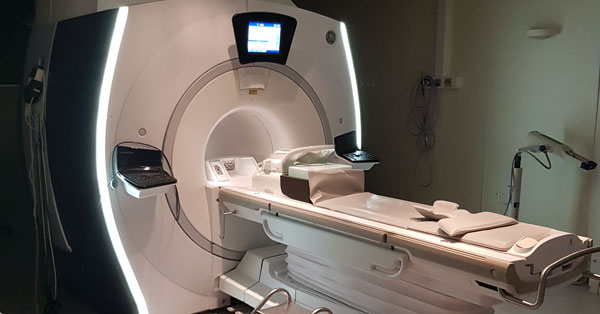
A GE 1.5T MRI machine is a jack-of-all-trades system.
With so many options available, finding the perfect system for your facility can be a daunting task.
Explore our GE 1.5T MRI reviews and uncover the unique offerings of each system including which ones have cost savings, newer technology, upgradeable software options, or excellent patient throughput.
- GE 1.5T Excite HDXT
- GE 1.5T Explorer
- GE 1.5T Optima 450 W
- GE 1.5T Optima 450
- GE 1.5T Optima MR 360 Advance
- GE 1.5T HD
- GE 1.5 Excite II
- GE 1.5T LX
If you’ve got your eye on a particular GE MRI model and are curious about pricing, check out our 1.5T MRI Machine Price Guide or contact our team below!
GE 1.5T Excite HDXT
The GE 1.5T Excite, is a reliable 16-channel system with a 60 cm bore. Engineered HD gradients ensure high-fidelity waveform accuracy, while HD Reconstruction enables real-time, high-performance image generation. With leading applications like CUBE and IDEAL, this system delivers premium-quality images with clarity and accuracy.
Additionally, the system features High-Density coils optimized for specific anatomical exams, further enhancing diagnostic accuracy and efficiency.
BEST FOR: Facilities looking for excellent patient throughput.
KEY SPECS:
-
CXK4 Magnet
-
60 cm Bore
-
16X or 23X Software
-
FOV 45 cm
-
8 or 16 Channel
GE 1.5T Explorer
The Explorer was introduced in 2015 and is powered by a 60cm bore, CXK4 magnet. This is the same CXK4 that has been used for over 20 years and praised for its stability and performance. Explorer systems use quiet technology which takes typical MRI noise down from rock concert levels to almost ambient– quiet enough to have a conversation in the same room.
The Explorer also uses Optix technology (like the 450W below) which improves SNR. Another compelling advantage: since it uses the CXK4 magnet, any version of GE MRI that also uses the CXK4 (LX and EXCITE series) can be upgraded to an Explorer with minimal downtime and substantially reduced cost. To compare possible upgrade options for your GE 1.5T MRI click here.
BEST FOR: Facilities looking for an ultra-reliable system with upgradeable features.
KEY SPECS:
-
60 cm Bore
-
CXK4 Magnet
-
Optix RF Technology
-
SV25 Software
GE 1.5T Optima 450W
Launched in 2010, this system is more available on the secondary market. The 450W features a redesigned magnet (goodbye CXK4) and the introduction of the “Optima” name – offered in 1.5T. The “W” in 450W means it is wide bore- 70cm, to accommodate larger patients or those who are claustrophobic.
This system also features an optical R/F system, “OpTix”, which improves SNR for clean, crisp images and an efficient zero boil-off magnet. The high slew rates make this an ideal choice for cardiology and neurovascular studies.
The 450W also employs the GEM Suite which makes the most of its 32ch capability by allowing coils to be used individually or together to provide head-to-toe coverage without excessive movement of the patient. This system can also come in a 16-channel version, that doesn’t include the GEM Suite – so you'll still have the wide-bore but with a better price point
A final notable fact: Similar to upgrades using the CXK4 magnet (mentioned above), the Optima 450W uses the same magnet as the newer Artist. So, like the CXK4-based upgrades, the magnet can be retained and the system can be upgraded to an Artist with minimal downtime and a reduced price.
BEST FOR: Facilities that want to deliver patient comfort without compromising quality or capability.
KEY SPECS:
- 70 cm Bore
-
LCC magnet
-
50cm FOV
-
OpTix RF technology
GE 1.5T Optima 450
The Optima 450 is the 60cm-bore version of the 450W. The system is a 1.5 HDXT machine upgraded to the current 23.0x software level, coined the “Optima Edition” hence, the new name. This iteration marks a significant advancement, combining the expanded bore size with cutting-edge software enhancements.
Notably, this upgrade maintains the traditional CXK4 magnet found in the LX and EXCITE series, presenting a clever integration of legacy reliability with modern innovation.
BEST FOR: Healthcare facilities seeking a blend of traditional reliability and modern innovation in their imaging technology.
KEY SPECS:
- 60cm Bore
- CXK4 Magnet
- 50 cm FOV
- 23X Software
GE 1.5T Optima MR360 Advance
A precursor to the Explorer and bridging the gap between the EXCITE HDXT 23X and Optima 450W, this 16-channel workhorse had its debut in 2013. According to GE, it was “engineered to address the demand for increased performance and reduced total cost of ownership for the facility, while providing a comfortable experience for the patient.”
Optix Technology was also used in this unit which, again, converts analog signal to digital within the scan room to minimize noise and enhance clarity. This unit also uses “Express coils” which can improve workflow by reducing the need to reposition coils between scans. The MR360 is energy efficient, using 34% less power than older systems.
BEST FOR: Healthcare facilities prioritizing operational and energy efficiency.
KEY SPECS:
- 60cm Bore
- XFD Gradients
- 16 Channel RF
- Two table design
GE 1.5T HD
This is the beginning of true HD imaging for GE. The 1.5T HD represents a step-change from the previous generation and includes a host of upgrades in software and hardware (new HFD gradient cabinet). Upgrading to the HD platform from an older LX system will give you expandability at an affordable price.
Remember, you can start with an HD, and then upgrade to an HDXT, and even go further with an upgrade to the 23x “Optima Edition” software/gradients.
BEST FOR: Healthcare facilities just starting in MR imaging and wanting to minimize upfront costs.
KEY SPECS:
-
CXK4 Magnet
-
12X Software
-
Linux Computer
-
8ch RF System
GE 1.5T Excite II
Remember how the Optima 450 (really just an HDXT with 23x software) was transitional to the Optima 450W? Well, here is the same scenario again, but with the Excite II and the LX (although this time there is no design change in the actual magnet).
The Excite II features the same ACGD cabinets as the previous LX series. However, it is equipped with a new Linux-based OS that can support 8-channel imaging. Age and availability lower upfront costs, if you don’t need the latest and greatest.
BEST FOR: Healthcare facilities just starting in MR imaging and wanting to minimize upfront costs.
KEY SPECS:
- CXK4 Magnet
- 11.0 Software
- Linux Computer
- LCD Color Monitor
- 8 Channel RF Amp
GE 1.5T LX
Using 9x software and an older Octane computer, this MR is dated but still seen on the secondary market. An important factor to consider when looking into this system is that it can only support up to 4 channels.
Another consideration should be which gradient cabinet is installed, since either the SGD (oldest) or the ACGD (newer) can be installed with an LX. These systems are equipped with HiSpeed or Echospeed gradients.
BEST FOR: Healthcare facilities just starting in MR imaging and wanting to minimize upfront costs.
KEY SPECS:
- CXK4 Magnet
- 9.1 Software
- Octane Computer
- LCD Color Monitor
The Takeaway
Whether you’re looking for cost savings, upgradeable software, or system stability, the GE 1.5T MRI models are versatile solutions for a wide range of imaging needs.
If you have questions or need help sourcing a particular MRI model, reach out to our team below-we’re happy to help!

Steve Rentz
Steve Rentz is the Product Manager for MRI Scanners at Block Imaging. Steve's goal is to earn each customer's trust and business by specifically addressing the needs of their unique project. When Steve is not helping customers with their MRI needs, he enjoys running, swimming, and woodworking.






